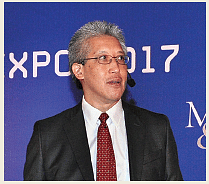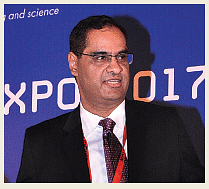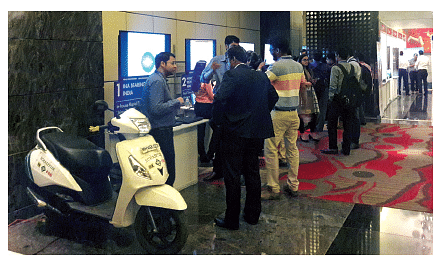Autonomy and data analytics key focus areas for MathWorks
MathWorks, the developer of mathematical computing software for engineers, is gearing up for new opportunities in autonomous vehicle technologies, electrification of powertrains, connectivity and the need to handle big data using its data analytics tools. Amit Panday reports.
Headquartered in Massachusetts, USA, MathWorks, the 33-year-old developer of mathematical computing software for engineers and scientists, is focusing on defining frameworks for several new technology areas within automotive and other sectors. New technology areas in the context of automotive industry include several levels of autonomous vehicle design, connectivity, electrification and hybridisation of vehicles worldwide and others.
Speaking to Autocar Professional on the sidelines of the Matlab Expo 2017 in Pune on April 25, Jim Tung, MathWorks Fellow at MathWorks USA, elaborated on the new tools and techniques that the company has recently added to Matlab, a programming software for algorithm development, data analysis, visualisation and numeric computation.

“Among the new tools and techniques for automated driving, we have just introduced a new toolbox for Matlab for doing automated driving design work including sensor fusion, definition of scenarios and ground truth labeling,” said Tung.
Defining ground truth labelling, a core task that defines on-ground situations for the development of algorithms for vehicle autonomy, Tung explained, “The issue with automated driving is that you need to drive cars in lots of different situations to gather data. That’s why all global companies (Google Waymo and others) are having automated cars being driven for miles to gather data. The problem is if you then want to teach the car how to react to different kinds of situations, you need to take all the videos and pictures taken from the cameras and identify each of them with humans, vehicle, road signs and other critical aspects. You have to label all the important pieces in the scene and then you can feed that data into the algorithm. This is what is called ground truth labeling. This is a very tedious job and takes a lot of manual work because someone has to identify each visual recorded thereby.”
According to Tung, one of the capabilities in the new toolbox that the company says it has now added to Matlab is the set of new techniques that help the developers automate a lot of that manual work. “It doesn’t make it go away but it does help automate this process to a great extent. Then you take that and you take the data coming from different kinds of sensors and connect to Matlab, which can then design algorithms based on these inputs. That’s one aspect of what we are doing,” Tung added.
According to the US-based senior official who has been working with MathWorks for almost three decades now, the company is also focusing on data analytics to not only handle but also to make sense of the big data that is generated from several sources in the development process.
“We are also focusing on is the data analytics of every type. That includes being able to handle very big data, which is too big to fit into your computer memory. Matlab users who know how to work on regular data can easily work on this big data too. One of the issues with ADAS and with automated driving is that you have lots of data from different sources and they all come in different times. But they all have to represent the same thing, so you need to take all this different data and snap it with the right time. There are various techniques for doing that. So that’s an important thing as well. And then the analytic methods including machine learning, deep learning are also very important. The capabilities of our products are packaged in a way that even if you know Matlab or you don’t know Matlab, it’s an easy way to learn the techniques. That’s the other emphasis for us,” he explained.
The company aims to provide standard algorithms with basic framework, which can then be used by the researchers in industry and academia to add their own findings to the process, moving the development process forward.
STRUCTURED FRAMEWORK

Speaking in this context, Kishore Rao, managing director, MathWorks India, said, “I think typically in this area a lot of companies have done work in terms of developing their own tooling and there is no standard framework that any one uses. For example, model-based design approach is very prevalent in the development of the powertrain. Now with the new toolbox, we are bringing in a more structured framework for companies to use for processes such as ground truth labeling, which is very manually intensive task. When you provide a framework and some level of automation within the tool, that just makes the whole process more efficient (towards the development of autonomous vehicle technologies). Similarly, there are other aspects in the framework, which will provide enhanced tooling capabilities.”

According to Tung, the new toolbox offers a well-integrated workflow with Simulink and model-based design capabilities and hence will easily connect with the existing developments in the engineering processes that will help the OEMs and the suppliers around the world.
Simulink, the company says, is a graphical environment for simulation and model-based design of multi-domain dynamic and embedded systems.
MathWorks is looking at new opportunities as the engineering projects within automotive to move forward in India and globally. “Electrification of the powertrain is another big focus area for all companies. The industry is now staring at hybrid and EV programs. When you get to electrification, you are talking of more complexities and about designing the entire system (vehicle architecture) and being able to optimise the battery management system (BMS). MathWorks tools, with its model-based design approach, are highly used in the development workflow of the hybrid vehicles,” added Rao.
The privately held company reported revenues of US$ 850 million in CY2016 with over 60 percent business from outside the USA. MathWorks employs over 3,500 people with 30 percent of the workforce located outside the USA, including India.
“In terms of revenues, we are well balanced across the America, Europe, Asia Pacific and other markets. If you look at automotive, all regions are growing for us because of the amount of smart tech that is increasingly going in the cars. With the focus on automated driving and machine learning and perception, our prospects of growth are very good in all regions,” stated Tung.
MathWorks claims its Matlab and Simulink platforms are used throughout the automotive, aerospace, communications, electronics, and industrial automation industries as fundamental tools for R&D. Automotive, not surprisingly, is understood to be one of the leading industries for MathWorks globally.
(This article was first officially published in Autocar Professional's 15th June 2017 issue)
RELATED ARTICLES
Tesla’s Test
Unlike in other markets, Tesla has taken a long-game approach in India, focusing on creating the infrastructure first.
‘India’s E20 Strategy Is the Template Europe Now Needs’
Mahle CEO Arnd Franz believes India’s flex-fuel shift is proving more resilient and market-aligned than the EU’s all-ele...
Forvia Shifts Focus, Expands India’s Role Beyond Services
New chief Martin Fischer is steering the Indian unit toward full-scale manufacturing, reshaping long-standing market pos...






 16 Jul 2017
16 Jul 2017
 13579 Views
13579 Views





 Ketan Thakkar
Ketan Thakkar



 Shahkar Abidi
Shahkar Abidi

